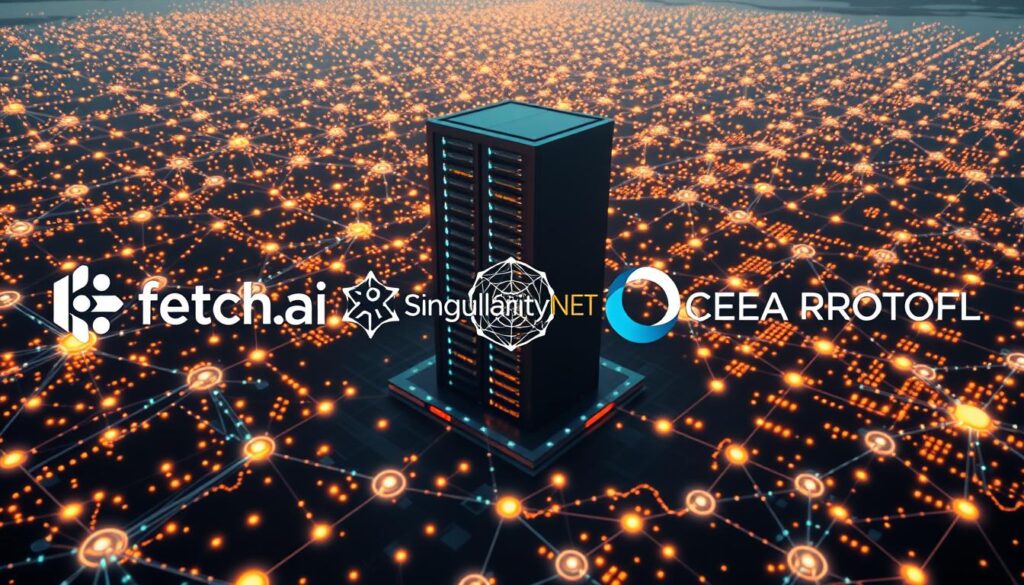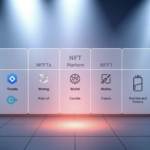Now Reading: Top Artificial Intelligence Crypto Projects with Highest Potential Revealed
- 01
Top Artificial Intelligence Crypto Projects with Highest Potential Revealed
Top Artificial Intelligence Crypto Projects with Highest Potential Revealed

Welcome to a concise product roundup aimed at U.S. readers who want a clear view of leading blockchain platforms that blend learning systems and practical utility. This intro frames how tokens and networks are being used to boost analytics, transaction speed, and user experience.
Expect a focused lens on fundamentals: team quality, code audits, tokenomics, and liquidity. We sample names like NEAR, ICP, Render, Bittensor, and The Graph to show how large market caps and active developer ecosystems drive 2025 interest.
Readers will see why these platforms matter now. Smart governance, anomaly detection for security, and stronger data access for dApps are repeating themes. We also flag risks—regulatory, privacy, and scaling—so decisions balance upside and caution.
Key Takeaways
- Focus on fundamentals: audit history, team, and token design matter most.
- Leading platforms turn learning systems into better analytics and UX.
- Large market caps and dev activity signal growing on-chain value.
- Compare interoperability, fees, and throughput before investing.
- Tokens align incentives among creators, nodes, and users.
- Watch for governance tools and security features that reduce risk.
Why AI-meets-blockchain matters right now in the United States
In the United States, pragmatic uses of ledger technology and predictive modeling are moving from labs to live services. This shift matters because it lowers fees, boosts speed, and tightens oversight for both retail and institutional users.
From smarter transactions to intelligent governance
Smarter transactions forecast fee conditions and batch operations to reduce costs and improve speed. That helps exchanges, wallets, and payment platforms cut operational overhead.
Intelligent governance systems can surface proposals, simulate outcomes, and flag anomalies. This yields clearer votes and more transparent community decisions under U.S. regulatory scrutiny.
How AI tokens power analytics, security, and user experience
Models scan on‑chain data in real time to spot fraud and unusual behavior. That enhances platform security and reduces exploit risk.
- Adaptive smart contracts adjust workflows for lending and settlements.
- Analytics pipelines turn multi‑chain histories into compliance-ready dashboards.
- Predictive UX alerts users to fee spikes and guides onboarding to lower friction.
| Benefit | How it helps | U.S. impact |
|---|---|---|
| Transaction optimization | Forecasting and batching | Lower costs, faster settlement |
| Governance simulation | Outcome modeling and anomaly flags | Clearer votes, fewer disputes |
| Security monitoring | Real‑time anomaly detection | Reduced fraud, better audit trails |
As tooling matures in 2025, these solutions will support safer, more compliant operations. For a deeper look at token-driven analytics and services, see AI token analysis.
artificial intelligence crypto projects with highest potential
We rank platforms by measurable adoption, code quality, and token utility rather than short-term price moves. The methodology below explains how market snapshots for NEAR, ICP, Render, Bittensor, and The Graph inform a balanced view of value and risk.
Methodology: market data, adoption, tokenomics, and audits
Selection pillars include on-chain adoption signals, verifiable developer traction, and sustainable tokenomics that show clear utility and sinks.
We pair market data—market cap and liquidity snapshots—with nonprice metrics: roadmap delivery, ecosystem integrations, and published audits. That avoids overreliance on volatile charts.
- Security and code quality: documented audits, active maintenance, and peer review matter most.
- Design trade-offs: throughput, latency, and storage costs are measured against target applications.
- Developer depth: subgraph libraries, subnet growth, or agent frameworks indicate resilience.
| Criterion | What we check | Why it matters |
|---|---|---|
| Tokenomics | Supply caps, sinks, incentives | Aligns creators, nodes, and users for durable value |
| Security | Audits, bug bounties, explorer metrics | Reduces exploit risk and boosts trust |
| Interoperability | Multi-chain data access, bridges | Enables liquidity routing and richer data for applications |
Finally, we weigh governance and transparency. Platforms that publish dashboards, explorer stats, and technical disclosures score higher for long-term US commercial adoption.
Bittensor (TAO): decentralized machine learning marketplace on-chain
A peer-scored network, Bittensor rewards useful contributions and lets developers tap collective models on-chain.
Overview: proof-of-intelligence, subnets, and TAO incentives
Proof-of-intelligence aligns rewards to quality. Peers score outputs and TAO flows to nodes that provide accurate, valuable information.
Subnets specialize tasks so models collaborate rather than duplicate work. That creates a marketplace where competing models and data producers earn tokens for useful responses.
Use cases: model sharing, predictive services, and external access
Developers and enterprises can query the collective for classification, forecasting, and embeddings via permissionless interfaces.
Use cases include anomaly detection, personalization, and analytics that avoid vendor lock-in by offering on-chain access to predictive services.
Growth signals: capped supply, network effects, and roadmap
TAO supply is capped at 21 million and halvings occur roughly every four years, supporting scarcity as demand for inference and training grows.
Miners supply computing and validators curate quality. Decentralized validation and reputation systems reduce risks like model poisoning.
| Feature | What it does | Why it matters |
|---|---|---|
| Proof-of-intelligence | Peer scoring of outputs | Rewards accurate models and deters low-quality submissions |
| Subnets | Task specialization and reward routing | Enables efficient marketplace matching and focused models |
| Token design | Capped supply, halvings, TAO rewards | Scarcity supports long-term value and aligns incentives |
| External access | Permissionless queries for services | Enterprise integration and developer monetization |
Subnet expansion, agent-framework integrations, and improved developer tooling are key growth signals. For a deeper monetary view of the protocol, see Bittensor monetary primitive.
Near Protocol (NEAR): sharded L1 for AI agents and scalable dApps
NEAR uses Nightshade sharding to split network load so nodes process fractions of total transactions. This parallelized execution raises throughput while keeping fees predictable and low. The design suits data‑intensive applications and agent-driven flows that need steady performance.

Nightshade sharding: speed, costs, and developer UX
Nightshade splits blocks into pieces so the network runs many shards in parallel. That lowers the compute burden per node and makes transaction confirmation faster. Predictable fees and high throughput make near‑real‑time interactions possible for bots and assistants.
Hosting agents and smart contracts at scale
Smart contracts on NEAR can host agents that transact, coordinate, and manage state across shards. Developers gain account abstractions and tooling that simplify onboarding and maintenance.
- Low costs and speed: enables responsive consumer apps and data pipelines.
- NEAR token: used for transactions, storage, and staking to secure the platform.
- Cross‑chain access: reduces complexity for multi‑chain data and liquidity integration.
| Capability | How NEAR delivers | Why it matters |
|---|---|---|
| Throughput | Nightshade parallelized execution | Handles many concurrent agent interactions |
| Costs | Predictable, low per‑transaction fees | Supports frequent, small transactions for apps |
| Developer UX | Account model, SDKs, and abstractions | Faster onboarding and lower maintenance |
| Data & interoperability | Full‑chain abstraction and cross‑chain tools | Easier access to multi‑chain data for applications |
Use cases include conversational agents in consumer apps, automated DeFi workflows, and high‑volume data processing pipelines. NEAR’s roadmap emphasizes agent hosting and interoperability, which helps ensure reliable performance under peak loads. For product teams where cost, speed, and developer ergonomics determine success, NEAR’s architecture solves real operational pain points.
Internet Computer (ICP): full-stack decentralized computing for AI
Internet Computer delivers full-stack decentralization that hosts frontends, backends, and persistent storage entirely on-chain. This approach lets teams run web apps and model checkpoints without off-chain servers, changing how applications handle uptime and trust.
Limitless smart contracts and on-chain UX/data
Canister smart contracts run web backends, frontends, and databases as cohesive units. That enables seamless UX where pages, APIs, and state live on the same blockchain.
Developers can deploy full applications and maintain persistent storage without traditional hosting. Predictable costs and steady throughput support real-time features.
Greentech, interoperability, and tamperproof models
ICP emphasizes Greentech and energy-aware computing to lower the carbon footprint of heavy workloads.
- AI models can be deployed inside tamperproof canisters to preserve integrity and auditability of inference and checkpoints.
- Direct integrations with major chains expand custody, DeFi, and multi-chain data use cases.
- Privacy advances like vetKeys enable confidential computation patterns for sensitive data.
| Feature | Benefit | Why it matters |
|---|---|---|
| On-chain canisters | Complete app hosting | Reduces centralized infrastructure risk and improves security |
| Greentech focus | Energy-efficient computing | Lower operational costs for sustainable deployments |
| Interoperability | Multi-chain integrations | Broader applications and richer data flows |
Bottom line: Internet Computer’s architecture can host end-to-end platforms that need data sovereignty, reproducibility, and consistent performance without relying on off-chain services.
Render Network (RENDER): distributed GPU power for AI and 3D workloads
Render Network connects creators and node operators on a practical GPU marketplace that scales on demand. The Ethereum-based platform lets creators submit render or training jobs while node operators lease GPU power and earn RENDER tokens for capacity and reliability.
Creators vs. node operators: tokenized GPU marketplace
Two sides interact transparently: creators post jobs, operators bid, and on-chain settlement ensures clear pricing and reliable payouts. Job pricing, escrow, and proofs of work run on blockchain to reduce disputes and speed settlement.
AI and VFX: speed, costs, and high-fidelity processing
Distributed processing shortens turnaround for inference bursts, training spikes, and VFX frames. Support for Blender Cycles, Redshift, Octane, Runway, and Stability tools makes the platform fit many applications.
- Encrypted asset handling and privacy controls protect large scene files and model checkpoints.
- Studios, indie creators, and research teams gain elastic capacity without owning hardware.
- As more operators join the network, queue times fall and geographic coverage improves.
| Feature | Benefit | Impact |
|---|---|---|
| Token rewards | Pay-for-performance | Attracts reliable resources |
| On-chain pricing | Transparent settlements | Trust for users and operators |
| Engine support | Broad tool compatibility | Faster adoption across studios |
Bottom line: Render positions itself at the intersection of model processing and digital content production. The tokenized marketplace lowers costs and delivers measurable ROI for creative and enterprise applications.
The Graph (GRT): indexing layer for AI-ready on-chain data
The Graph turns raw on-chain logs into fast, reusable APIs that power modern analytics.
Subgraphs, GraphQL, and multi-chain access
Subgraphs are open APIs that define which on‑chain information to index and how to store it for fast queries.
GraphQL provides developer-friendly queries so applications retrieve precise results across multiple chains with minimal overhead.
Fueling analytics, DeFi queries, and AI pipelines
AI pipelines pull labeled histories and event timelines from subgraphs for feature engineering, model training, and real‑time triggers.
This reduces operational burden: teams avoid building custom indexers and gain decentralized, reliable access to blockchain data.
- DeFi apps query high-frequency metrics for liquidity, lending, and derivatives risk checks.
- Curation and indexing roles align incentives to keep popular subgraphs accurate and up to date.
- Migration steps to Arbitrum cut gas and speed queries under load, improving network reliability.
| Benefit | How it helps | Who gains |
|---|---|---|
| Standard schemas | Faster integrations | developers, users |
| Multi‑chain views | Unified reporting and compliance | platforms, analytics teams |
| Decentralized indexing | Lower ops cost | applications and models |
Bottom line: The Graph provides predictable, verifiable data access that accelerates development and model-driven products across the blockchain ecosystem.
Artificial Superintelligence Alliance (FET): Fetch.ai, SingularityNET, and Ocean united
A new coalition links autonomous agents, marketplaces, and consented datasets into a single decentralized stack.

What it is: Fetch.ai, SingularityNET, and Ocean Protocol—joined by CUDOS—combine agent execution, service discovery, and data monetization on blockchain rails.
Agents, AI services marketplace, and data sharing
Agents transact and negotiate on-chain to complete tasks while calling composable models from a marketplace.
Private data lanes and compute allow model training and evaluation without exposing raw records, enabling safe data sharing for regulated uses.
Path to AGI/ASI with open, decentralized governance
Governance aims to stay open and distributed so decisions reduce concentration risk and align rewards to contributors and users.
Interoperability ties agent logic, service discovery, and data monetization into one cohesive platform that speeds developer time‑to‑market.
- Use cases: logistics automation, predictive maintenance, and web3 assistants that coordinate multi-step workflows.
- Data provenance and consent tooling support healthcare and finance compliance needs.
- Tokens secure access, staking, and quality incentives, drawing community, partners, and liquidity to strengthen network effects.
| Component | Role | Benefit |
|---|---|---|
| Agents | Autonomous task execution | Reduced manual orchestration |
| Marketplaces | Composable model services | Faster integration and monetization |
| Data lanes | Privacy-preserving access | Safer model training and auditability |
Virtuals Protocol: ownable AI agents for games and social platforms
Ownable agents act as digital workers that can talk, trade, and manage assets on behalf of holders. These agents run autonomous routines, interact inside apps, and carry state so they can perform tasks without constant human intervention.
Initial Agent Offerings (IAO) let creators fractionalize agent ownership via a marketplace model. Buyers secure shares in high-potential agents tied to gaming or social applications, enabling shared upside if an agent earns revenue.
Built on Base, the protocol benefits from lower fees and fast confirmations. That L2 network design suits interactive, high-frequency engagements and keeps user friction low.
Monetization paths include in-game services, social engagement fees, and sponsorships that translate into yields for token holders. Trading of agent shares tracks performance metrics and reputation, creating liquid markets for successful agents.
Agents require on-chain and off-chain data: state, memory, and context. Anchoring provenance on blockchain improves composability and auditability while compute orchestration handles inference bursts off-chain when resources are needed.
- Easy deployment: agents drop into platforms and worlds with configurable behaviors and permissions.
- Scalability: hybrid compute for peak loads while transactions and ownership live on-chain.
- Commercial fit: partnerships with studios and social apps can accelerate adoption and align creators, communities, and investors.
| Feature | Benefit | Why it matters |
|---|---|---|
| IAO marketplace | Fractional ownership | Shared revenue streams for small investors |
| Base L2 | Low fees, fast confirms | Responsive user experience for live interactions |
| Data & compute | On-chain provenance + off-chain inference | Proves history and scales performance |
Story Protocol (IP): programmable IP and AI model licensing on-chain
Creators now can mint rights, track lineage, and automate payments directly on a dedicated chain. Story Protocol is a Layer‑1 built to register, license, and monetize intellectual property on the blockchain.
On‑chain registration immutably records provenance and ownership. That reduces rampant remixing and improves authenticity for generated works and traditional art.

On-chain licensing and royalties
Programmable smart contracts execute license terms and distribute royalties in near real time. Creators can define splits, usage limits, and revocation rules inside contracts for clear, auditable payouts.
Models as licensable assets
The platform supports models as tokenized assets with explicit usage rights and audit trails. Contracts enforce permissions and log usage information so licensees and creators share transparent records.
- Token holders can stake to secure the network and join governance.
- Metadata, content hashes, and licensing status use standardized data structures for external tool compatibility.
- Market integrations let dApps and marketplaces consume licensed assets under compliant terms.
| Feature | Benefit | Who gains |
|---|---|---|
| On‑chain registration | Immutable provenance | Creators, brands |
| Programmable contracts | Automated royalties | Rightsholders, licensors |
| Model licensing | Auditable usage | Enterprises, developers |
Governance lets the community vote on fee schedules, dispute rules, and policy changes. For a deeper protocol overview, see Story Protocol explained.
Snorter Bot ($SNORT) and SUBBD ($SUBBD): AI tools for trading and the creator economy
Two new solutions bring real-time trading and creator monetization into chat and web dashboards.
Snorter: Telegram trading, security, and fee utilities
Snorter focuses on faster meme coin execution inside Telegram. It offers token sniping, copy trading, and limit orders for rapid entry and exit.
Built-in scam detection flags honeypots and rug pulls to improve security. $SNORT grants fee discounts, staking rewards, and possible airdrops for active participants.
SUBBD: AI assistants, subscriptions, and fan engagement
SUBBD targets creators with subscriptions, paywalls, live streams, tipping, and AI assistants that automate content and comments.
Staking yields about 20% APY. Early presale traction—over $700k raised and a 1B supply—signals initial momentum toward thousands of creators.
- Data signals and feeds power better execution and creator analytics.
- User experience is simple: Telegram bots plus web dashboards for non-technical users.
- Token-gated access unlocks premium perks and creator roles.
| Feature | Snorter ($SNORT) | SUBBD ($SUBBD) |
|---|---|---|
| Primary use | Fast trading tools | Creator subscriptions |
| Token utilities | Fee discounts, staking, airdrops | Staking APY, access, tipping rewards |
| Security & compliance | Scam detection, monitoring | Privacy controls, content moderation |
| Early traction | Presale ~$1.2M (500M supply) | Presale >$700k (1B supply) |
Bottom line: Both tools translate practical models into usable applications that boost trading efficiency and creator monetization on blockchain rails. Fee structures and clear access models will shape adoption and costs for retail users.
How AI enhances blockchain technology, security, and transactions
Real‑time models turn scattered ledger signals into clear security alerts for operations teams. These systems combine historical records and live feeds to spot unusual address behavior, abnormal flows, or strange contract calls.

Machine learning models for anomaly detection and fraud prevention
Machine learning models ingest historical and streaming data from wallets, nodes, and exchanges to flag outliers in address patterns and contract interactions.
Model-based risk scores feed automated controls. Protocols can trigger freezes, alerts, or manual review when risk exceeds thresholds.
Optimizing transaction timing, fees, and throughput
Predictive analytics forecast mempool congestion and dynamic fee markets. That helps wallets choose timing that reduces costs and speeds confirmations.
Automation also parallels validation and offloads repetitive checks, improving throughput while cutting human error.
- Unified information pipelines pull signals across chains, wallets, and exchanges to enrich detection.
- Rules engines work alongside learning systems to lower false positives and catch complex exploits.
- Privacy‑preserving aggregation and differential methods keep data useful while meeting compliance needs.
- Simulation tools stress test contract upgrades and governance proposals before deployment.
| Capability | How it works | Benefit |
|---|---|---|
| Anomaly detection | Historical + real‑time data fed to models | Faster fraud identification and reduced loss |
| Risk scoring | Model outputs trigger automated controls | Clear escalation paths and fewer false alarms |
| Fee optimization | Predictive mempool and fee models | Lower transaction costs and better UX |
| Throughput automation | Parallelized validation and workflow automation | Higher processing rates and fewer delays |
Practical solutions emerge where security operations, fee markets, and protocol engineering meet. These improvements raise user trust and platform resilience—key factors for mainstream adoption. For further research on model-driven token services, see AI cryptocurrency research.
Key factors to evaluate AI crypto platforms before buying
Making a sound buy decision starts with fundamentals, not hype. Focus on measurable signals that show a platform can deliver real value and survive market stress.
Team, code quality, audits, and governance
Start with people: founders’ track records, engineering hires, and visible shipping cadence indicate execution risk.
Check public repositories, test coverage, and recent audits. Active maintenance and third‑party reviews reduce the chance of surprises.
Governance matters: transparent upgrade processes, clear voting power, and on‑chain proposals show how the platform adapts under stress.
Tokenomics, utility, and data/network effects
Assess supply caps, emission curves, sinks, and real utility. Well-designed tokens align users, operators, and developers.
Platforms that improve as more participants join—strong data access or compute marketplaces—create compounding advantages.
Scalability, infrastructure, and developer ecosystem
Evaluate sharding, L2 integrations, or specialized runtimes that match target workloads. Scalability choices affect latency, cost, and long-term value.
Developer docs, SDKs, and sample integrations shorten time‑to‑market and drive adoption. Look for live customers and production deployments.
| Factor | What to check | Why it matters |
|---|---|---|
| Team | Founders’ history, engineering hires | Execution and trust |
| Code & audits | Repo activity, test coverage, audit reports | Operational risk reduction |
| Tokenomics | Supply, emissions, utility sinks | Long‑term alignment and scarcity |
| Data & network effects | Quality of indexed data, compute marketplace activity | Compounding adoption and better services |
| Scalability & infra | Sharding, L2s, runtimes | Cost, latency, throughput |
Final tip: weigh liquidity, listings, and real customer references before allocating capital. Balance upside against clear regulatory and market risks.
Risks, regulation, and privacy in AI-driven crypto networks
Risk management must evolve as compute-heavy models meet blockchain constraints and user expectations.
Data protection is central. Models can process sensitive on‑chain and off‑chain information. That raises exposure from leaks, profiling, or unauthorized reuse. Teams must build robust privacy controls and auditing to reduce harm.
Scalability trade-offs and ethical data sharing
Integrating heavy compute atop a blockchain creates throughput and cost trade-offs. High-demand jobs can cause congestion and higher fees for other users.
Mitigations include hybrid compute (off‑chain inference), batching, and selective disclosure to lower on‑chain load while keeping auditability.
- Define consent-driven data flows to respect GDPR/CCPA-style rights.
- Use privacy-enhancing tech such as selective proof systems and differential methods.
- Run regular audits, red-team tests, and incident drills to catch model theft or poisoning.
| Risk | Why it matters | Mitigation |
|---|---|---|
| Data leakage | Sensitive info exposed via model outputs | Access controls, selective disclosure, logging |
| Adversarial attacks | Inputs that skew model decisions | Robust testing, adversarial training, monitoring |
| Regulatory action | U.S. scrutiny on market integrity and disclosures | Clear documentation, legal reviews, compliance hooks |
| Scalability strain | Network congestion and higher fees | Hybrid architectures, queuing, dynamic pricing |
Cross‑border data rules complicate deployments; residency and transfer limits can force regional architectures.
Community and user education sustain trust. Publish incident reports, explain data use, and keep channels open for feedback. Risk management is ongoing and must adapt as technology and policy shift.
Positioning these platforms in a forward-looking crypto portfolio
Build a layered allocation that matches each platform’s role in data, compute, and applications. Split exposure across GPU markets (Render), indexing (The Graph), decentralized models (Bittensor, FET Alliance), and app-layer tools (Snorter, SUBBD, Virtuals).
Anchor core bets in NEAR and ICP, and size higher‑beta tokens for asymmetric upside. Tie positions to clear use cases—agent economies, creator monetization, enterprise data pipelines—and track on-chain data and developer activity as leading indicators.
Diversify to reduce idiosyncratic risk and enforce risk controls: position sizing, staged entries, and dynamic hedging for active trading. Favor platforms that show customer references, measurable user value, and deep liquidity for practical entries and exits.
Principle: durable value follows sustainable technology and real solutions, not narrative cycles.













